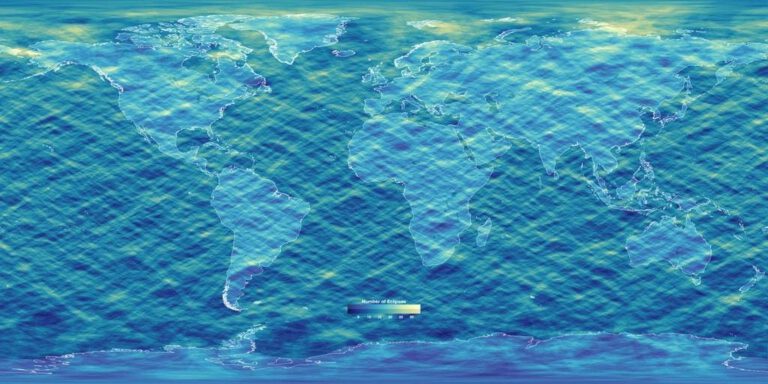A heatmap showing the frequency of total solar eclipses over the 5000 years from 2000 BCE to 3000 … [+]
How often do solar eclipses occur? NASA’s new “heat map” showing the geographical distribution of total solar eclipses has revealed that any specific location on Earth experiences a total solar eclipse once every 366 years, on average.
That makes what happens on April 8 in parts of southern Illinois, Missouri and Kentucky somewhat remarkable. On that days a quadrant covering about 32,400 square miles (52,200 square kilometers) will experience totality for 4 minutes 9 seconds just six years, years months and 18 days after enjoying 2 minutes 38 seconds during the last “Great American Eclipse.”
The inhabitants of Perryville and Cape Girardeau in Missouri, Paducah in Kentucky and Carbondale, Du QuoinMarion, Makanda, Harrisburg and Metropolis in Illinois are poised for an incredibly rare occurrence.
The paths of the 2017 and 2024 total solar eclipses across the U.S.
When The Next Eclipse Is
NASA’s map—this article’s main image—contains the paths of 3,742 total and hybrid solar eclipses across the 5,000 years between 2,000 B.C.and 3,000 C.E. It was created using the Five Millennium Canon of Solar Eclipses, a list of eclipses calculated by Fred Espenak and Jean Meeus and published in 2006.
Every single pixel on the map sees at least one total solar eclipse during that period, with each one seeing 13.66, on average.
“Dividing 5,000 years by this figure produces an average of 366 years between eclipses,” states the website. “This number is almost exactly halfway between the estimates of 360 by Russel et al. in their 1926 astronomy textbook and 375 by Jean Meeus in a 1982 paper published in the Journal of the British Astronomical Association.”
A graph of the average number of total eclipses experienced at each latitude in the eclipse … [+]
Where The Most Total Solar Eclipses Happen
The map, developed by Ernie Wright at NASA’s Scientific Visualization Studio, revealed some interesting facts about the actual distribution and frequency of total solar eclipses across the planet:
- Each and every pixel on the map experiences between one and 35 total solar eclipses in 5,000 years.
- Total solar eclipses are more likely to happen in the northern hemisphere than in the southern hemisphere (which is the result of the Earth’s slightly lopsided elliptical orbit around the sun).
- Total solar eclipses are also more likely in the summer (largely because the sun is ‘up’ longer).
How Often Total Solar Eclipses Happen
Although it’s rare to experience a total solar eclipse twice in one place during one human lifetime, total solar eclipses are not rare on our planet. A solar eclipse of some kind happens on Earth between two and five times each year, with total solar eclipses sometimes occurring 354 days apart—the exact length of a lunar year.
That’s 12 orbits of the moon around the Earth. But it can be much longer. For example, after April 8, the following total solar eclipse is on August 12, 2026—a gap of 856 days, or 30 lunations. However, a total solar eclipse occurs on Earth, on average, once every 18 months.
For the latest on all aspects of April 8’s total solar eclipse in North America, check my main feed for new articles each day.
Wishing you clear skies and wide eyes.












